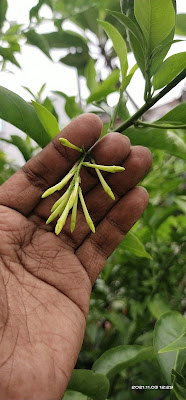Cestrum nocturnum commonly known as Night Blooming Jasmine has the best long-term fragrance that cover a huge area around the garden region - they seems to emit the scent far more stronger and longer throughout the night. However as strange as it seemed - the scent mysteriously disappear during day time without any hit of those scent.
This Jasmine also known with many different names such as: Lady of the Night, Night Jasmine, Dama de Noche, Galan de Noche and Queen of the Night. Night blooming Jasmine is native to Central and South America and the West Indies, however been cultivated in most tropical & subtropical regions around the world. This tropical plant is hardy and easy to care for and cultivate.
The flowers are in tubular shape almost like needle like clustered inflorescent flowering plant. It has the greenish white coloration and only blooms at night.
Also on the side note - this plant is also identified to have psychoactive elements however more research and studies is in progress.
Considering one of the most basic thing about planting material - this one doesn't require anything special - just any balanced potting mix will do. They seem to do fine in a medium or big potted plant - however they will do great if they are planted directly into the garden soil as these will require just that to produce those lovely blooms.
However if limitation occurs where you can only grow in pot - then a good balanced potting mix with rich amount of organic material and equal part of well drained soil which will help from root rot.
It may require a good adequate watering - both morning and evening based on the size of the plant.
You can grow it in a nice medium or large size pot, the plant will behave and grow based on the size of the pot. However I would recommend this to grow freely on ground if you want lushful beautiful constant blooms.
Also this plant is a heavy feeder and do feed adequately during the flowering season.
One of the most challenging part for this shrub is pruning. They do grow extremely fast and become very unruly if not proper care is not given - especially when it comes to growth factor, this plant focus more on branching more stem and over growth rather than blooms which can be one of the down-side coming from this ever blooming plant.
However with the right pruning method and keeping it trimmed and manageable size - this one can be such a beauty. As shown here - the appearance of the blooms can last at least for few months until the next pruning session is done to maintain the blooming cycle from interruption.
This consideration applies very accurately when the plant is matured and had grown for years - that is if it is not flowering in its full potential. Other factors involving lighting / watering / feeding is also essential and necessary.
PROPAGATION:
Propagation can be done but stem cutting, stripping off the bottom leaves and poking it into a deep pot with a rich potting soil. Keep it in shade until you notice a new leaves growth.
Another method is to put the cutting into perlite medium (soaked in water) Once taken roots, it should be carefully transplanted into a good potting mix.. Another alternative is seed propagation Being from a member of a nightshade family - these appear to be easy to propagate in comparison to other types of Jasmines.
TOXICITY:
This particular Jasmine is not a true Jasmine but from a potato family from the member of the nightshade family which is often associated with toxicity - in this case, all parts of the plants are poisonous if ingested. They also do from attractive clustered white berries like fruits which are poisonous and therefore do practice caution when having children or pets around which may accidentally consume them.




























2 comments:
I appreciate the detailed information on caring for the Night Blooming Jasmine. Your insights on its light and soil needs are especially helpful. For anyone looking to dive deeper into how to properly prune this plant, click here to read more. This resource provides great tips to ensure your Jasmine thrives and blooms beautifully. Thanks for sharing such valuable content!
Hi Rida,
Thanks for sharing additional details concerning this plant.
I hope you are the author of the blog you are sharing.
Post a Comment